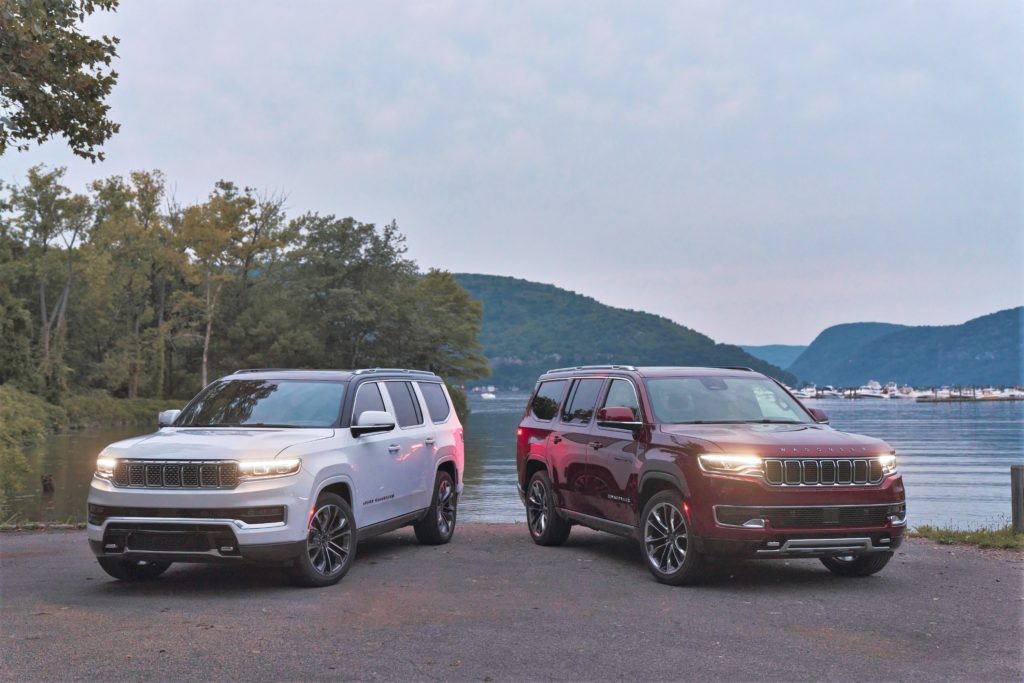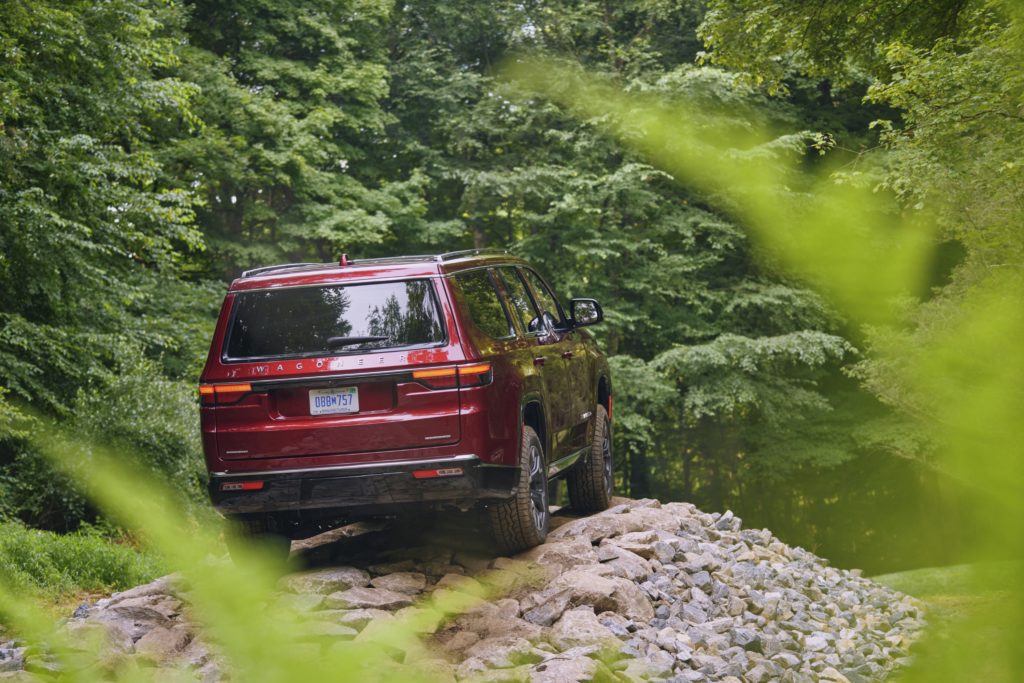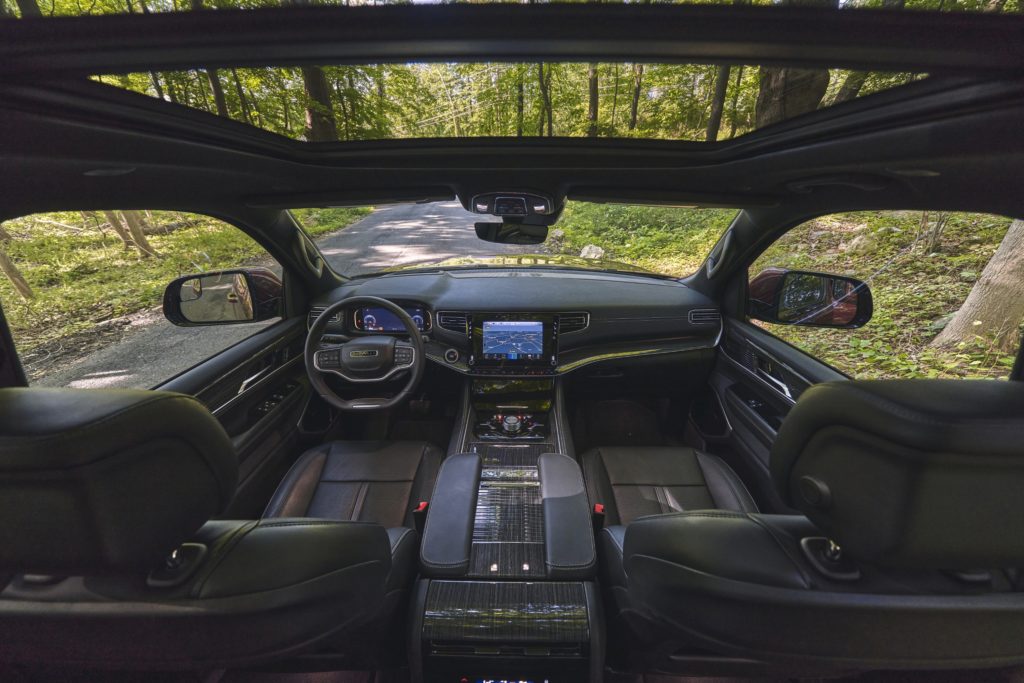By: Jeffrey Zygmont
A whole lot is praiseworthy, and a whole lot is interesting about the new Wagoneer and Grand Wagoneer sport-utility vehicles from Jeep. Most interesting – and even peculiar – is the introduction of these particular models at this particular moment.

But first, the background.
Introduced midway through 2021 as a 2022 model, this hulking, three-row, eight-passenger wagon is the largest vehicle ever produced by Jeep. Its two varieties, the Wagoneer and Grand Wagoneer, are separated by price and luxury level. Both have the same big-box, aggressively vertical body over the same road-going mechanicals, available with either rear-wheel or four-wheel drive. Dropping the Grand from its title, the Wagoneer is the more middle-market version, with a starting price of about $63,000. The Grand Wagoneer starts above $90,000 and packs in more lavish trappings. Think of multiple video screens and touch-pad controllers, hands-free automatic driving aids, conspicuous wooden dashboard inlays, sumptuous seat upholstery – the list could get long. The Grand Wagoneer also has a larger, more powerful V-8 engine than the V-8 in the base Wagoneer.
During my week-long evaluation of the Grand Wagoneer, the model proved to be darn comfortable and darn luxurious. The new Wagoneers are precisely the sort of mega-hauler that many Americans signal they want to drive. This has been made evident by the popularity of other mega-haulers like the middle-brow Ford Expedition, Chevrolet Suburban, and Nissan Armada and the premium GMC Yukon Denali, Cadillac Escalade, and Lincoln Navigator.

I think the Wagoneer and Grand Wagoneer will replace lots of those well-established rivals in American garages. My experience in the Grand Wagoneer showed that it offers everything those other max-capacity luxury haulers provide, along with a noticeable dose of finesse. I test-drove a top-level Series III version, priced at about $107,000 before options. It came with an automatic-retracting step below the doors on the driver and passenger sides. In other vehicles, the device would be called a running board. In the Grand Wagoneer, it’s too well disguised and integrated to call it that. It appears very neatly and discretely to be simply the wagon’s bottom-most sill – an integral part of the car’s body exactly the way you’d expect that part to look. But open a door, or approach with the key in your pocket, and the bottom sill rolls outward to magically transform into a long step beneath the doors, at precisely the height you need. I welcomed the help entering and exiting the high-riding Grand Wagoneer I tested, which was boosted higher by big, 22-inch wheels.
The Grand Wagoneer also may surpass the class in maneuverability – a big deal in a vehicle this large. Like other max-capacity sport utilities, the Grand Wagoneer rides on a pickup truck frame. A hefty, rigid under-body frame of the type supporting pickups seems necessary in passenger wagons this size. Their manufacturers load the vehicles with comforts and rig them for easy riding. But below deck, they can’t escape the wide-load waywardness of a pickup. I had expected such limited mobility in the Grand Wagoneer. But driving it was a happy surprise. Wheedling around a grocery store lot and into a parking spot, I said aloud, “That was easy.”
But the most significant advantage for the Grand Wagoneer is its parentage. Jeep’s reputation for go-anywhere, do-anything transportation carries down from the original World War II Army jeep, a distant ancestor of today’s popular Jeep Wrangler. People buy sport utilities for the same please-get-me-there qualities popularly associated with the Army jeep/Jeep Wrangler – commanding presence, hefty protection, and dependable traction. As sport-utility vehicles, the Wagoneers’ attachment to Jeep gives them an image advantage over a mere Cadillac or Lincoln.

That makes you wonder why Jeep doesn’t shout louder about the connection. The company seems to want it two ways. Although Jeep sells the middle-brow Wagoneer and the upper-crust Grand Wagoneer through regular Jeep dealers, a Jeep badge doesn’t appear on the new models. In its press materials and on its websites, the company trumpets the models’ Jeep heritage. But it lists the Wagoneers under a separate, independent heading rather than as new members of the Jeep family. Press releases categorize the two new models as “a premium extension of the Jeep brand.”
Some media reports state that Jeep wants a higher-class image for the Wagoneers, so it’s maintaining some separation between them and its more middle-class Jeep models. Maybe. Or maybe the large, gasoline-fueled V-8 engines required to move these big wagons would drag the average fuel economy of the Jeep fleet as a whole too low to please government censors. Jeep might avoid that by sticking them in a separate, off-brand category. I need to do more research on that topic.
For now, the most peculiar aspect of the Wagoneers is their arrival today, when the car industry seems primarily focused on its efforts to go green, which means shunning gasoline-burning conventional power systems and going electric. Almost all the product-development and R&D press releases you read from car companies today crow about electric-car programs.
But the all-new Wagoneer and Grand Wagoneer have the characteristics of traditional American vehicles. They’re big, powerful, comfortable, and protective. We know many consumers want those qualities because we see roadways heavily populated by Chevy Suburbans, Ford Expeditions, Cadillac Escalades, Lincoln Navigators, and other max-capacity cruisers.
We know that Jeep understands those characteristics remain popular too. It spent large sums on research, engineering, and now manufacturing of the new Wagoneers, convinced that buyers would be eager to trade in their Suburbans, Expeditions, Escalades, Navigators, and other big haulers.
Car companies are pulled in two opposing directions today. As in any heavily regulated business, they have to heed and cooperate with their regulators. But they also have to please their customers, who buy and rely on their vehicles. Today, the market shows clearly that the drive into electric propulsion is not consumer-driven. Until and unless that changes, it’s nice to see Jeep pleasing ordinary people with its new Wagoneers.

No comments yet.